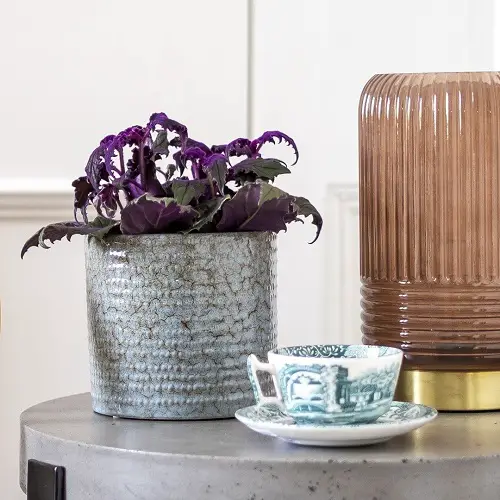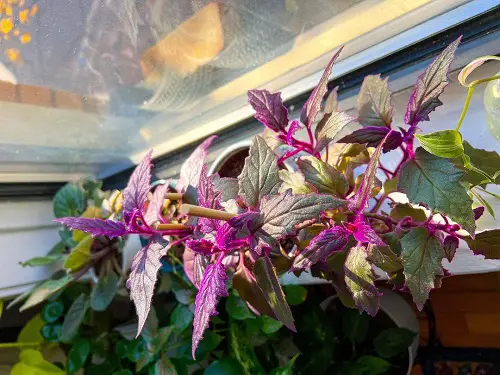Add some striking color and texture to your indoor plant collection with the Purple Passion Plant! Here’s a detailed guide!

Purple Passion Plant is sure to turn heads with its velvety leaves and eye-catching hue,. Caring for this beauty requires some specific attention to detail. Let us explore all the tips and tricks you need to keep it thriving!
Here is our Begonia Maculata Care and Growing Guide
Purple Passion Plant Information

The Purple Passion Plant is a unique and eye-catching houseplant that is sure to turn heads. This plant is native to Indonesia and is a member of the Asteraceae family. Its most striking feature is its purple leaves, which are covered in a soft, velvety fuzz that gives them a tactile quality. The texture of the leaves is what inspired the “Passion” part of the plant’s name, as they feel like the skin of a peach or nectarine!
Despite its exotic origins, the Purple Passion Plant is quite easy to care for. It grows to be about 12 to 18 inches tall, making it a great choice for smaller spaces. The leaves are the star of the show, but the plant does produce small yellow flowers in the fall and winter.
Botanical Name: Gynura aurantiaca
USDA Zones: 10-11
Common Names: Purple Passion, Velvet Plant, and Royal Velvet Plant
Looking for exotic plants? Check out Exotic Dwarf Tree Like Houseplants for Homes here
Propagating Purple Passion Plant

Propagating a Purple Passion Plant is a great way to create new plants to add to your collection or share with friends. It can be propagated through stem cuttings, which can be taken any time of year, although it is best to do so in the spring or summer months.
From Seeds:
- Fill a seed tray or pot with moistened seed-starting mix.
- Sprinkle the Purple Passion Plant seeds on top of the soil and lightly press them in.
- Cover the tray or pot with plastic wrap to maintain humidity.
- Place the tray or pot in a warm, bright location out of direct sunlight.
- Keep the soil moist but not waterlogged, and mist as needed.
- After 2-3 weeks, germination should occur. Once the seedlings have 2-3 sets of leaves, transplant them into individual pots filled with potting.
Note: It’s important to keep in mind that not all seeds will germinate, and some may take longer than others.
Here are 12 Simple Seed Germination Tips To Grow Every Seed
From Stem Cuttings:
- Cut a 4-6 inch section from a healthy stem of the Purple Passion Plant and remove the lower leaves.
- Dip the cut end in rooting hormone powder and plant in moistened potting soil.
- Cover the pot with a clear plastic bag and place it in a bright, warm location.
- Water regularly to keep the soil moist but not waterlogged.
- After a few weeks, check for roots and remove the plastic bag.
- Continue caring for the plant until it is mature enough to be transplanted.
Note: Use clean, sterile tools and soil, and avoid direct sunlight during the rooting process to prevent the cutting from drying out.
Check out this amazing Plant Propagation Using a Strip of Foam Trick!
Best Pot Size for Growing Purple Passion Plant
When it comes to growing Purple Passion Plant, choosing the right pot size is important for the plant’s overall health and growth. As a rule of thumb, it’s best to choose a pot that’s slightly larger than the current root ball of the plant.
You can start the plant in a 8-10 inches pot, which will be good for the next 2-3 years. After that, depending on the growth and spread, kep on re-potting it into one size bigger container than the old one.
Here are Plant Pot Sizes from Inches to Gallon
Requirements for Growing Purple Passion Plant

Sunlight
The Purple Passion Plant requires bright, indirect sunlight to thrive. Too much direct sunlight can scorch the leaves, while too little light can cause the plant to become leggy and weak.
You should place your plant in a location where it receives bright, filtered light for a few hours a day but is shaded during the hottest part of the day.
Soil
The plant prefers well-draining, slightly acidic soil with a pH of 5.5-6.5. A good potting mix for Purple Passion Plant should contain a combination of peat moss, perlite, and vermiculite.
Learn some Great Tips to Rejuvenate Your Old Soil here
Water
The Purple Passion Plant prefers to be kept consistently moist but not waterlogged. Overwatering can lead to root rot and other problems, while underwatering can cause the plant to wilt and dry out.
A good rule of thumb is to water the plant when the top inch of soil feels dry to the touch. During the growing season, the plant may require more frequent watering, while in the winter, it may require less.
Here are the best ways to water plants
Temperature and Humidity
It prefers warm temperatures between 60-85°F (16-29°C) and high humidity levels. Avoid placing Purple Passion Plant near cold drafts or heaters, as sudden temperature changes can cause stress and damage to the plant.
To increase humidity levels around the plant, consider placing a humidifier nearby, misting the leaves with water, or placing a tray of water near the plant to evaporate.
Here are 10 Ways To Increase Humidity For Houseplants That Work
Purple Passion Plant Care
Fertilizer
While the Purple Passion Plant does not require frequent fertilization, occasional fertilization during the growing season can help promote healthy growth and foliage.
A balanced, water-soluble fertilizer diluted to half strength can be applied once a month during the growing season. Be sure to follow the manufacturer’s instructions and avoid overfertilization, which can lead to burned roots and foliage.
Here are Effective Homemade Lawn Fertilizers That Are Safe From Hazardous Chemicals
Pruning
It benefits from occasional pruning to maintain its shape and promote healthy growth. Prune back leggy or straggly stems in the spring to encourage branching and fuller growth.
Additionally, remove any yellow or damaged leaves or stems as soon as possible to prevent the spread of disease.
Pests and Diseases
While the Purple Passion Plant is generally a hardy and disease-resistant plant, it can still be susceptible to some pests and diseases.
Common pests that may affect this plant include spider mites, mealybugs, and scale insects. Keep a close eye on your plant for any signs of pest infestation, such as webbing, sticky residue, or small insects on the foliage or stems.
If you do spot pests, remove them manually or treat the plant with insecticidal soap or neem oil.
Additionally, the Purple Passion Plant may be susceptible to fungal diseases, such as root rot or powdery mildew, if overwatered or grown in conditions with poor air circulation. To prevent these diseases, ensure the plant is not overwatered and provide adequate air circulation around the plant.




Where can I get seeds for the purple passion plant